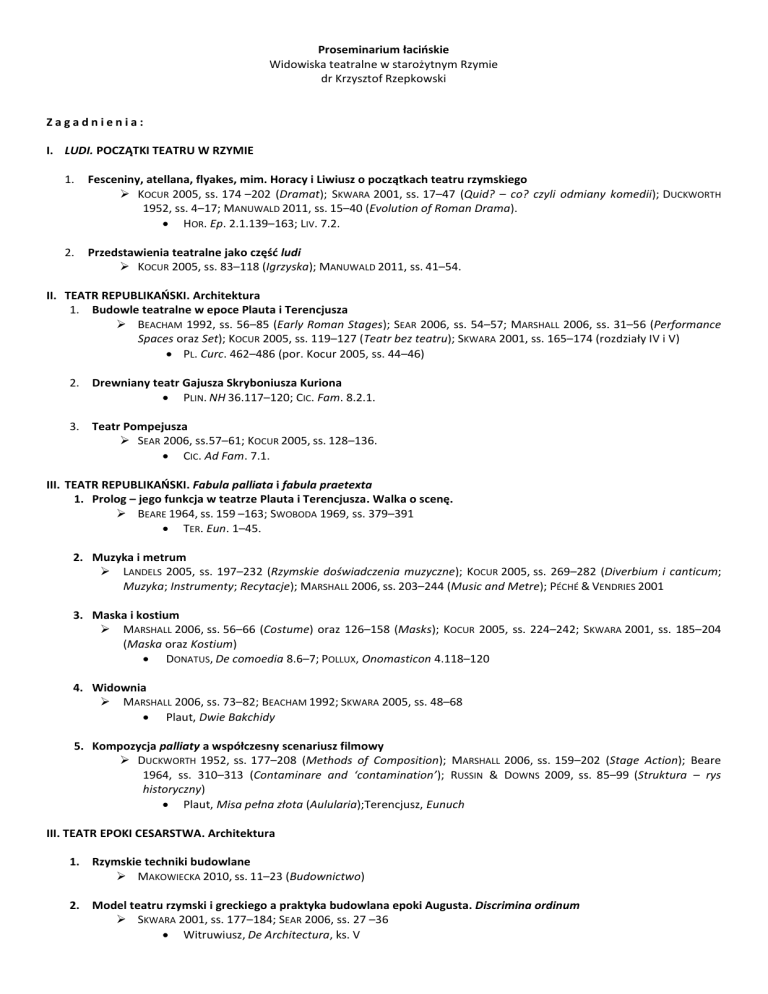
Proseminarium łacioskie
Widowiska teatralne w starożytnym Rzymie
dr Krzysztof Rzepkowski
Zagadnienia:
I. LUDI. POCZĄTKI TEATRU W RZYMIE
1.
Fesceniny, atellana, flyakes, mim. Horacy i Liwiusz o początkach teatru rzymskiego
KOCUR 2005, ss. 174 –202 (Dramat); SKWARA 2001, ss. 17–47 (Quid? – co? czyli odmiany komedii); DUCKWORTH
1952, ss. 4–17; MANUWALD 2011, ss. 15–40 (Evolution of Roman Drama).
HOR. Ep. 2.1.139–163; LIV. 7.2.
2.
Przedstawienia teatralne jako część ludi
KOCUR 2005, ss. 83–118 (Igrzyska); MANUWALD 2011, ss. 41–54.
II. TEATR REPUBLIKAŃSKI. Architektura
1. Budowle teatralne w epoce Plauta i Terencjusza
BEACHAM 1992, ss. 56–85 (Early Roman Stages); SEAR 2006, ss. 54–57; MARSHALL 2006, ss. 31–56 (Performance
Spaces oraz Set); KOCUR 2005, ss. 119–127 (Teatr bez teatru); SKWARA 2001, ss. 165–174 (rozdziały IV i V)
PL. Curc. 462–486 (por. Kocur 2005, ss. 44–46)
2. Drewniany teatr Gajusza Skryboniusza Kuriona
PLIN. NH 36.117–120; CIC. Fam. 8.2.1.
3. Teatr Pompejusza
SEAR 2006, ss.57–61; KOCUR 2005, ss. 128–136.
CIC. Ad Fam. 7.1.
III. TEATR REPUBLIKAŃSKI. Fabula palliata i fabula praetexta
1. Prolog – jego funkcja w teatrze Plauta i Terencjusza. Walka o scenę.
BEARE 1964, ss. 159 –163; SWOBODA 1969, ss. 379–391
TER. Eun. 1–45.
2. Muzyka i metrum
LANDELS 2005, ss. 197–232 (Rzymskie doświadczenia muzyczne); KOCUR 2005, ss. 269–282 (Diverbium i canticum;
Muzyka; Instrumenty; Recytacje); MARSHALL 2006, ss. 203–244 (Music and Metre); PÉCHÉ & VENDRIES 2001
3. Maska i kostium
MARSHALL 2006, ss. 56–66 (Costume) oraz 126–158 (Masks); KOCUR 2005, ss. 224–242; SKWARA 2001, ss. 185–204
(Maska oraz Kostium)
DONATUS, De comoedia 8.6–7; POLLUX, Onomasticon 4.118–120
4. Widownia
MARSHALL 2006, ss. 73–82; BEACHAM 1992; SKWARA 2005, ss. 48–68
Plaut, Dwie Bakchidy
5. Kompozycja palliaty a współczesny scenariusz filmowy
DUCKWORTH 1952, ss. 177–208 (Methods of Composition); MARSHALL 2006, ss. 159–202 (Stage Action); Beare
1964, ss. 310–313 (Contaminare and ‘contamination’); RUSSIN & DOWNS 2009, ss. 85–99 (Struktura – rys
historyczny)
Plaut, Misa pełna złota (Aulularia);Terencjusz, Eunuch
III. TEATR EPOKI CESARSTWA. Architektura
1. Rzymskie techniki budowlane
MAKOWIECKA 2010, ss. 11–23 (Budownictwo)
2. Model teatru rzymski i greckiego a praktyka budowlana epoki Augusta. Discrimina ordinum
SKWARA 2001, ss. 177–184; SEAR 2006, ss. 27 –36
Witruwiusz, De Architectura, ks. V
3. Teatry kamienne. Teatr na planie miasta rzymskiego
MAKOWIECKA 2010, ss. 52–57; SEAR 2006, ss. 61–67; KOCUR 2005, ss. 136–144.
III. TEATR EPOKI CESARSTWA. Mim i pantomima
LADA-RICHARDS 2007, ss. 12–37; MANUWALD 2006, ss. 178 –186; HALL & R. WYLES 2008, ss. 1–42.
Lukian z Samosate, Dialog o taocu
BIBLIOGRAFIA
Literatura podstawowa:
1. R.C. BEACHAM, The Roman Theatre and Its Audience, Harvard 1992.
2. G. MANUWALD, Roman Republican Theatre, Cambridge 2011.
3. J.G. LANDELS, Muzyka starożytnej Grecji i Rzymu, Kraków 2005 (rozdział Rzymskie doświadczenia muzyczne).
4. M. KOCUR, We władzy teatru. Aktorzy i widzowie w antycznym Rzymie, Wrocław 2005.
5. E. MAKOWIECKA, Sztuka Rzymu. Od Augusta do Konstantyna, Warszawa 2010 (rozdział Budownictwo oraz podrozdziały
Amfiteatr i Teatr)
6. C.W. MARSHALL, The Stagecraft and Performance of Roman Comedy, Cambridge 2006.
7. E. SKWARA, Historia komedii rzymskiej, Warszawa 2001.
Literatura uzupełniająca:
3
1. W. BEARE, The Roman Stage, London 1964 .
2. C.R. DODWELL, Anglo-saxon Gestures and the Roman Stage, Cambridge 2000.
3. G.E. DUCKWORTH, The Nature of Roman Comedy, Princeton 1952.
4. F. DUPONT, Le théâtre latin, Paris 1999.
5. F. DUPONT, L’Acteur-roi. Le théâtre dans la Rome antique, Paris 2003.
6. E. HALL & R. WYLES, New Directions In Ancient Pantomime, Oxford 2008.
7. E. KARAKASIS, Terence and the Language of Roman Comedy, Cambridge 2005.
8. I. LADA-RICHARDS, Silence Eloquence: Lucian and Pantomime Dancing, London 2007.
9. H.N. PARKER, ‘Plautus vs. Terence: Audience and Popularity Re-Examined’, The American Journal of Philology 117 (1996),
ss. 585–617.
10. V. PÉCHÉ et CH. VENDRIES, Musique et spectacles dans la Rome antique, Paris 2001.
11. R.U. RUSSIN & W.M. DOWNS, Jak napisać scenariusz filmowy, Warszawa 2009.
12. F. SEAR, Roman Theatres. An Architectural Study, Oxford 2006.
13. E. SEGAL, Roman Laughter. The Comedy of Plautus, Oxford 1987.
14. E. SKWARA, ‘Widz w teatrze Plauta. Charakterystyka rzymskiego odbiorcy na podstawie komedii Bacchides’, Meander 1
(2005), ss. 48–68.
15. M. SWOBODA, ‘Spór Luscjusza Lanuwinusa z Terencjuszem’, Meander 24 (1969), ss. 379–391.
